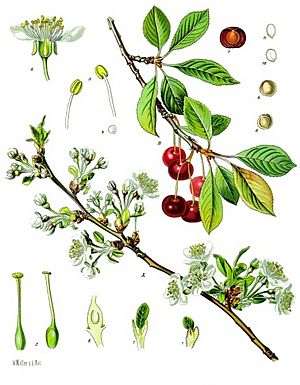True cherries facts for kids
Quick facts for kids True cherries |
|
|---|---|
 |
|
| Illustration of Prunus cerasus | |
| Scientific classification |
|
| Kingdom: | Plantae |
| Clade: | Tracheophytes |
| Clade: | Angiosperms |
| Clade: | Eudicots |
| Clade: | Rosids |
| Order: | Rosales |
| Family: | Rosaceae |
| Genus: | Prunus |
| Subgenus: | P. subg. Cerasus (Mill.) A.Gray, 1856 |
| Species | |
|
See text |
|
Prunus subg. Cerasus is a special group of plants within the larger Prunus family. This group is often called true cherries. You can find these trees and bushes in the cooler parts of the Northern Hemisphere. This includes places like North America, Europe, North Africa, and Asia.
True cherries have some unique features. Each branch has a single bud where new growth starts. Their flowers usually grow in small bunches, but sometimes they appear alone. The fruit is a type of drupe, which means it has a hard pit inside, like a peach or plum. This fruit does not have a clear groove on its side.
Many types of true cherries are enjoyed by people. For example, sweet cherries are eaten fresh all over the world. Chinese cherries are popular in China. Other types, like sour cherries, are used to make yummy desserts, sauces, jams, and even wine. The seeds of mahaleb cherry are used to make a spice called mahleb. Beyond their fruit, many true cherry species are grown just for their beautiful cherry blossoms, which are a stunning sight in spring.
Contents
What Are True Cherries?
True cherries belong to a specific subgenus called Prunus subg. Cerasus. Think of a subgenus as a smaller group within a larger plant family. This helps scientists organize and understand different types of plants.
Where True Cherries Grow
These plants are found naturally in many parts of the world.
- In North America, you can find species like P. emarginata and P. pensylvanica.
- Europe is home to four species: P. avium, P. cerasus, P. fruticosa, and P. mahaleb.
- Two species, P. avium and P. mahaleb, also grow in North Africa.
- Most other true cherry species are found across Asia.
Different Kinds of True Cherries
There are many different species of true cherries. Each one has its own unique features. Here are a few examples of the true cherry species:
- Prunus avium: Also known as sweet cherry or wild cherry. This is the one you often eat fresh.
- Prunus cerasus: This is the sour cherry, great for baking and making jams.
- Prunus campanulata: Called bell-flowered cherry or Taiwan cherry, known for its pretty flowers.
- Prunus serrula: Known as paperbark cherry because of its interesting bark.
- Prunus serrulata: This is the famous Japanese cherry, also called Oriental cherry, known for its stunning cherry blossoms.
Hybrid Cherries
Sometimes, different cherry species can cross-breed naturally. This creates new types of cherries called nothospecies or hybrids. These hybrids combine features from their parent plants. For example, the Yoshino cherry (Prunus × yedoensis) is a well-known hybrid that produces beautiful flowers.
Cherries That Are Not "True Cherries"
It might sound confusing, but not all plants called "cherry" are part of the Prunus subg. Cerasus group. These other cherries belong to different subgenera within the larger Prunus family.
- Bush Cherries: These include plants like Oriental bush cherry and Nanking cherry. They have three winter buds per branch, unlike the single bud of true cherries. They are now grouped under Prunus subg. Prunus.
- Bird Cherries and Cherry Laurels: Examples are bird cherry and cherry laurel. Their flowers and fruits grow in long clusters called racemes. These belong to Prunus subg. Padus.
- African Cherry: The African cherry (P. africana) is another type of cherry, but scientists are still figuring out exactly where it fits in the Prunus family. It is definitely not a true cherry.
See also
 In Spanish: Cerasus para niños
In Spanish: Cerasus para niños

